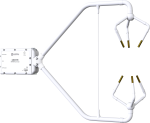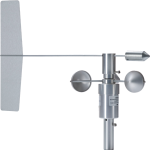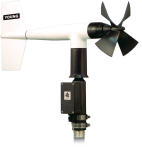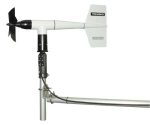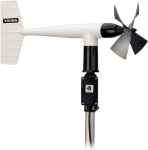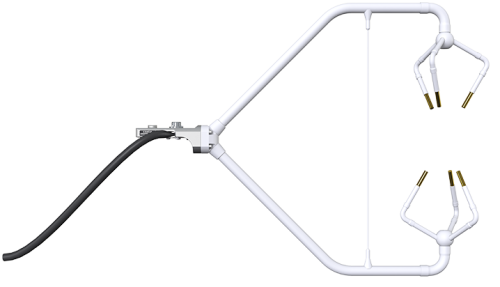
Best instrument for flux and other high-level turbulence research projects






Overview
The CSAT3A sonic anemometer head is similar to the sensor head from the CSAT3 sonic anemometer, but its cable is modified to connect to the EC100 electronics. It is used as part of the EC150 open-path analyzer and the CPEC200 closed-path eddy-covariance system.
Read MoreBenefits and Features
- New conformal coating helps protect sonic transducers in corrosive environments
- Innovative design provides precision turbulence measurements with minimal flow distortion
- Usually combined with EC150 or EC155 gas analyzers giving near complete colocation for eddy-covariance measurements
- Compatible with most Campbell Scientific data loggers
- Measurements can be used to calculate momentum flux and friction velocity
- Campbell Scientific’s fine wire thermocouples are an option for fast-response temperature measurements
- Field rugged
- Innovative signal processing and transducer wicks considerably improve performance of the anemometer during rain events
- Sealed sonic transducers and electronics
Technical Description
The CSAT3A is an optional component of an EC150 open-path or EC155 closed-path CO2/H2O gas analyzer. It attaches to a common mounting bracket and connects to the gas analyzer's EC100 electronics module.
Images



Related Products
Compatibility
Specifications
| Measurement Path Length |
|
| Path Angle from Horizontal | 60° |
| Construction | Sealed sonic transducers and electronics |
| Anemometer Head Materials | Stainless-steel tubing |
| Electronics Box Materials | Welded aluminum |
| Operating Temperature Range | -30° to +50°C |
| Voltage Supply | 10 to 16 Vdc |
| Current |
|
| Digital SDM Output Signal | CSI 33.3 k baud serial interface for data logger/sensor communication. (Data type is 2-byte integer per output plus 2-byte diagnostic.) |
| Support Arm Diameter | 1.59 cm (0.63 in.) |
| Transducer Diameter | 0.64 cm (0.25 in.) |
| Transducer Mounting Arm Diameter | 0.84 cm (0.33 in.) |
| Anemometer Head Dimensions | 47.3 x 42.4 cm (18.6 x 16.7 in.) |
| Anemometer Head Weight | 1.7 kg (3.7 lb) |
Measurements |
|
| Outputs |
ux, uy, uz, c (ux, uy, uz are wind components referenced to the anemometer axes; c is speed of sound.) |
| Speed of Sound | Determined from three acoustic paths; corrected for crosswind effects. |
| Measurement Rate | Programmable from 1 to 60 Hz, instantaneous measurements. Two over-sampled modes are block averaged to either 20 Hz or 10 Hz. |
| Output Bandwidths | 5, 10, 12.5, or 20 Hz |
| Output Rate | 10, 20, 25, or 50 Hz |
| Measurement Resolution |
|
| Offset Error |
|
| Gain Error |
|
| Rain | Innovative ultrasonic signal processing and user-installable wicks considerably improve the performance of the anemometer under all rain events. |
Digital USB and RS-485 Output Signal |
|
| Baud Rate | 230400 bps (maximum) |
| Data Type | Comma-delimited ASCII |
SDM, USB, & RS-485 Digital Outputs Reporting Range |
|
| Full-Scale Wind | ±65.535 m/s autoranging between four ranges (Least significant bit is 0.25 to 2 mm/s.) |
| Speed of Sound | 300 to 366 m/s (-50° to +60°C) Least significant bit is 1 mm/s (0.002°C). |
Resources and Links
Product Brochures
Manuals
- EC150 CO2 and H2O Open-Path Gas Analyzer and EC100 Electronics with Optional CSAT3A 3D Sonic Anemometer - 900
- CSAT3 3-D Sonic Anemometer - 347
- Open Path Eddy Covariance System with IRGASON or EC150/CSAT3A Quick Deploy Guide
- EC155 CO2 and H2O Closed-Path Gas Analyzer and EC100 Electronics with Optional CSAT3A 3D Sonic Anemometer - 905
FAQs for
Number of FAQs related to CSAT3A: 22
Expand AllCollapse All
-
No. The sonic anemometer does not report time with the wind measurements. A time stamp will be assigned to the wind data by the data-acquisition system—either a data logger or a PC.
-
No. The CSAT3/3A/3AH is a sensor. Time stamps are assigned to the sonic anemometer data by the data-acquisition system—typically a Campbell Scientific data logger or PC.
-
The sensors used in the eddy-covariance application are not compatible with SCWin. An open-path eddy-covariance program is available for purchase as pn 18442, CRBasic Basic Eddy Covariance Program. This is the program without energy balance sensors. Also available is pn 18443, CRBasic Extended Eddy Covariance Program, with energy balance sensors. To order a custom configured program, contact the Environmental Group for assistance.
-
The CSAT3/3A/3H is compatible with three output signals: analog, RS-232, and Synchronous Device for Measurement (SDM). The sonic anemometer can be interfaced to any data-acquisition system that is compatible with analog measurements or RS-232 serial communications. SDM is used with Campbell Scientific data loggers.
-
Campbell Scientific does not offer any mounting booms or hardware that enable easy and frequent positioning of the sonic anemometer sensor head. This type of hardware must be provided by the user.
-
The CSAT3A or CSAT3B is calibrated over the temperature range of -30° to +50°C. The sonic anemometer operating temperature range can be shifted by 10 degrees to cover the range of -40° to +40°C. For low-temperature applications, it may be more appropriate to consider a heated version of our sonic anemometers.
The instrument will continue to operate outside the calibrated temperature range until the signal becomes too weak; however, the proper calibration will not be applied to the measurements because the calibration file only spans the specified temperature range.
-
The CSAT3/3A/3AH calibration applies a correction for transducer delay over temperature. Transducer delays cause an offset in the wind speed measurement, and to a lesser extent, an offset in the speed of sound measurement.
The CSAT3/3A/3AH speed of sound easement is corrected for the effects of wind blowing normal to the sonic path.
-
Ultrasonic anemometers are unable to make measurements if the sonic path is blocked. The path may become blocked by water that puddles on the lower transducer face or droplets that hang from the upper transducers. Sonic wicks, which come with all sonics, can be placed on the transducers to wick away moisture from the faces of the transducers. Ensure that these wicks are removed during cold conditions to prevent ice from building up around them.
-
No. The offset is a function of temperature and time. Once a year, spot-check the sonic anemometer wind offset using the procedure outlined in the CSAT3B instruction manual. If the measured offset is outside the specification, return the sensor to the factory for calibration. To request a return material authorization (RMA) number, follow the steps listed on our Repair and Calibration page.
-
Yes. If the matching layer is damaged or missing, return the sonic anemometer to the factory for repair. Follow the steps listed on our Repair and Calibration page to request a return material authorization (RMA) number.
Case Studies
With instrumentation and help from Campbell Scientific, personnel from the Department of Atmospheric Sciences at......read more
Articles and Press Releases
Privacy Policy Update
We've updated our privacy policy. Learn More
Cookie Consent
Update your cookie preferences. Update Cookie Preferences
